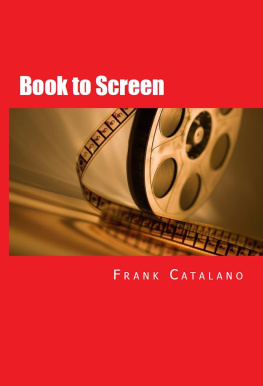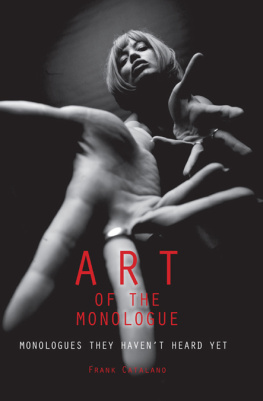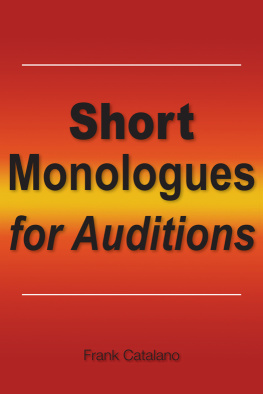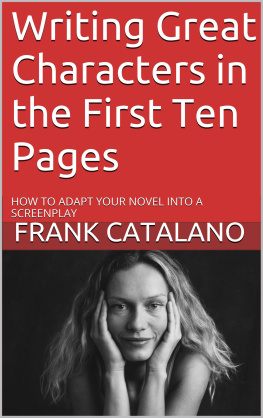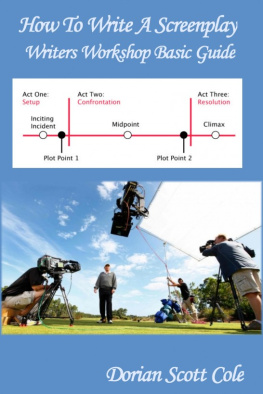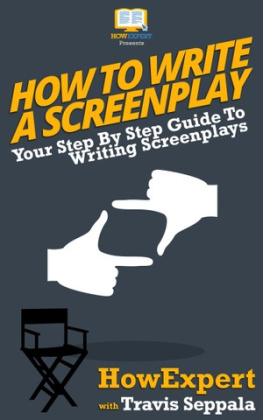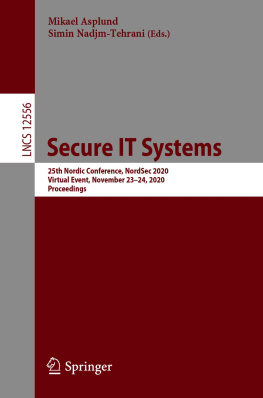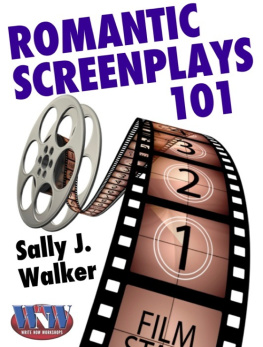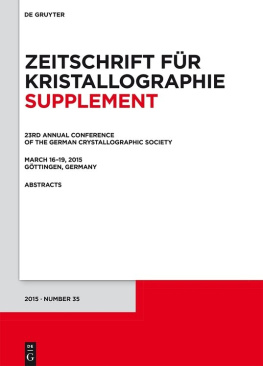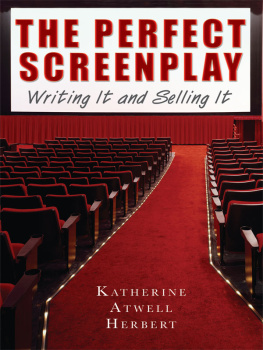BOOK TO SCREEN
HOW TO ADAPT YOUR NOVEL INTO A SCREENPLAY
COMPILATION OF SEMINARS HELD AT THE 25TH ANNUAL WRITERS CONFERENCE
SAN DIEGO STATE UNIVERSITY
Copyright 2009 / 2015 Frank Catalano
All rights reserved. No part of this book may be reproduced or transmitted in any form or by any means without written permission from the author.
ISBN-13: 0692282947
ISBN-10: 9780692282946
Lexington Avenue Press
www.lexingtonavepress.com
818-994-2779
Books by Frank Catalano
Art of the Monologue
Monologues they havent heard yet
The Creative Audience
The collaborative role of the audience
In the creation of the visual and performing arts
White Knight Black Night
Short monologues for auditions
The Resting Place
a play
Autumn Sweet
a play
Rand Unwrapped
Confessions of a Robotech Warrior
Che Che
A screenplay
Short Monologues for Auditions
Book to Screen is a compilation of lectures presented by Frank Catalano as part of the 25th Annual Writers Conference. The conference was sponsored by San Diego State University on February 6 through the 8th, 2009 at the Double Tree Hilton Hotel in Mission Hills, California. The following transcripts were presented and recorded by Frank Catalano as part of the programs offered at the conference. This book is in part based upon this and other seminars presented by Mr. Catalano.
Writers of fiction and non-fiction and industry professionals from the publishing business primarily attended the 25th Annual Writers Conference. Mr. Catalanos seminars focused upon those writers seeking to adapt their novels into screenplays. The complete list of seminar presentations by Frank Catalano for this conference that have been published as individual volumes are:
TABLE OF CONTENTS
BOOK TO SCREEN
HOW TO ADAPT YOUR NOVEL INTO A SCREENPLAY
COMPILATION OF SEMINARS HELD AT THE 25TH ANNUAL WRITERS CONFERENCE
SAN DIEGO STATE UNIVERSITY
FRANK CATALANO
Introduction
I want to welcome you to BOOK TO SCREEN and the 25th Annual Writers Conference. It has been a great weekend!
Okay, we are a very eclectic group today from all parts of the country so this is going to be a lot of fun. What I want to talk to all of you about today is the conversion of a novel to a screenplay. There are several different ways I want to approach this topic. But first, for those of you that I havent already met, I wanted to provide to you a little bit of background information about me. Before I forget, I am also sending around a sheet so that you can put your name and an email address so that I can send you written notes from todays presentation. That is of course optional you do not have to provide contact information.
My name is Frank Catalano. I am a college professor teaching at the School of Theatre (now School of Dramatic Arts as of 2012). I teach acting, writing and theatre and all different kinds of elements of presentational performance. I also teach Humanities courses that include visual and performing arts: painting, sculpture, film, television and audience studies. My acting classes are both on camera and stage. As a theatre producer/playwright I have had productions at the Beverly Hills Playhouse in Los Angeles and have had shows produced in New York City and other parts of the country.
In addition to academia, I was an executive at Warner Brothers Studios and Lorimar Productions probably the longest. I had various positions including consultancies, packaging, marketing and writing. I had what is called a first look writing agreement at Warner Brothers for the development of motion pictures and television productions. Working at a movie studio is a great experience. The studio provides a framework to develop everything you write although they are not obligated to produce it. So you set up shop there, you write, you work with other writers sometimes. But, the hard part of that process is that not very much gets actually made. In a large studio universe, producing was something totally different than writing. I just primarily focused on the writing.
I am also an author. I have two books out: Art of the Monologue (2007). Its a theatre book for actors with original monologues and a large section on monologue performance theory. Ive also had plays produced and published. I have a new play being published right now and I have a brand new book coming out this month called The Creative Audience The Collaborative Role of the Audience in the Creation of Visual and Performing Arts (2009) and so it is not being sold in the lobby.
Since this 2009 presentation, Frank Catalano has published the following books:
Art of the Moologue (2007)
The Creative Audience (2009)
White Knight Black Night Short Monologues for Auditions (2010)
Autumn Sweet a Play (2011)
The Resting Place a Play (2011)
Rand Unwrapped Confessions of a Robotech Warrior (2013)
Che Che A Screenplay (2013)
Short Monologues for Auditions (2013)
Today, in this final presentation I want to put together all of the seminars we have had this weekend. So some of this is review and there will also be some new material.
So, lets get started.
WRITING GREAT CHARATCTERS IN THE FIRST TEN PAGES
SAN DIEGO STATE UNIVERSITY
25th Annual Writers Conference
WORKSHOP TRANSCRIPT
HOW TO ADAPT YOUR NOVEL INTO A SCREENPLAY
BOOK 1
Frank Catalano
Page to Screen
Writing Great Characters in the First Ten Pages
The presentation of your work to others is almost as important as the idea (the work) itself. Thats what I was thinking of before I came here today to meet all of you. What would be the best frame to put this seminar in? WRITING GREAT CHARACTERS IN THE FIRST TEN PAGES? What does this title actually mean? Lets think of it this way. We have all probably been to McDonalds or Burger King?
(Audience laughter)
I know you have. You probably wont admit it.
(Audience laughter)
And what are you getting? We hope that its a beef patty. Right? And why did we go there? Because eating fast good is a fast and inexpensive way to eat. We didnt go there for the atmosphere. Now lets take that same beef patty and place it in a really fancy restaurant. In Los Angles, we have Wolfgang Pucks Grill in Beverly Hills. Now lets take that same hamburger patty and maybe change the shape of it a little so it doesnt look like a patty. We add carrots, potatoes, garnish sauce and other things around it. Present it in soft amber lighting, candles, and violin music playing and now that hamburger patty that was under a dollar costs thirty dollars.
(Audience laughter)
But what has changed? Nothing. The only thing thats changed is the frame that the patty has been placed within. And this is important to stress. It is not a lie in the sense that Im not taking out the patty and putting it in my pocket and replacing it with a filet mignon steak. No, its the same patty. What has changed is the point of view and the framework of the presentation. That is the most important thing. The idea remains the same. By extension, the process for writing characters or converting characters from a novel is quite the same thing. Its all how you frame them at the start of your story.
I want to explore the differences between the two mediums. So with that in mind, how many of you are active screenwriters?
(Audience member raising hand)
Ive got one Ive got two. And you?
(Audience member: Off and on)
But you have written screenplays. Have any of your screenplays been put into production?
(Audience member: No, but its been work shopped.)
Okay. How about you?
(Audience member: Im going to make my own film.)
Great! Wonderful. And you know what? Thats the future. When you go to Warner Brothers and other majors and they might tell you, Well, we just dont know what to do with your project it doesnt fit in it just wont work for us. Then there people, right out of film school, that dont know the rules (thats a good thing). They arent aware of what they are supposed to do or not do because the schools they attend never prepare them that way.
Next page
